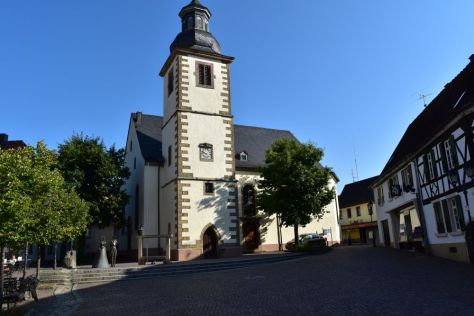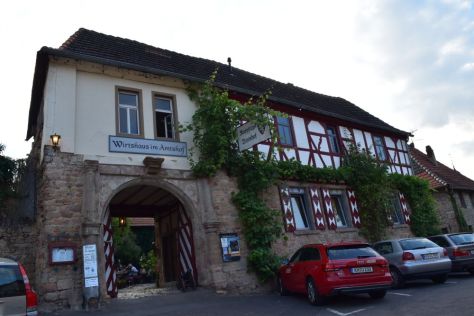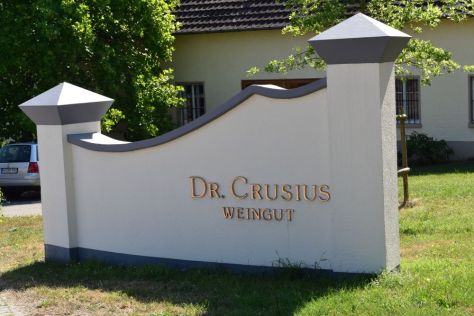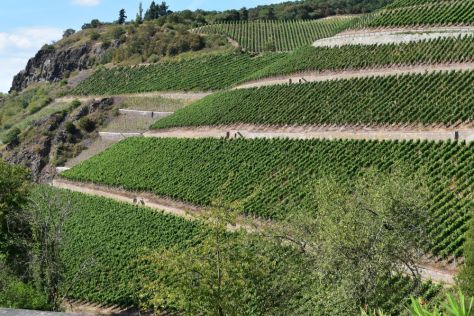On our ninth day through Germany we drive to Bad Münster-Ebernbach in the Nahe valley. It is now the last day of August.
.
First stop at Rockenhausen, a friendly country town
Shortly after breakfast we feel like a coffee and stop in Rockenhausen. It is a friendly, small town with a clock museum,…

… a central market square with a church…

… and a cute monument in front of the church including these rabbits.

We have our espresso and buy some self knitted baby socks in the shop nearby that celebrates “ten years of the busy thread”. It is the kind of shops that sorely has disappeared in our towns: Just wool and filz and some hand knitted stuff.
.
The Nahe valley – Dr. Crusius at Traisen and the highest cliff north of the Alps
We drive through the Alsenz valley and reach the river Nahe. Behind a huge-huge rock we stop in the wine village Traisen. We find Dr. Crusius, a winegrower that I had selected from my Little Johnson for being an excellent family estate.
The daughter of Dr. Crusius opens the door. I buy two bottles of Riesling and a late harvest Riesling from the Bastei, a small band of vineyards below the Rosental rock. It is the highest rock in Europe north of the Alps (202m). The sun almost “roasts” the grapes here. We take pictures from the Rosental view point. Impressive. This is the upriver view.

This is the view down river towards Ebernbach.

.
The Nahe valley – Döhnhoff at Oberhausen
We drive along the Nahe to Oberhausen. We oscillate a bit, until we find the traditional winegrower Hermann Dönhoff in the Bahnhofstrasse. This winegrower, Johnson says, is perhaps Germany’s best. I expect a huge and representative tasting and selling area with a lot of staff working there. We find the wife of Dönhoff – she is under stress, as she is cooking a meal for guests that are expected to arrive soon. We find her husband in a rather modest selling and tasting area, also under stress, because he has promised to join his wife now. But, okay, he can sell me some Riesling. I buy two bottles of Grand Cru and a late harvest from Hermannsberg, the steepest and best rated vineyard in the Nahe region, just above a bent of the river. Mr. Dönhoff is proud of his wine, and when he hears me laugh about “Dellchen” (another name for a vineyard here, “little dent”), he mumbles something and disappears to fetch a description of his vineyards: “Look, this is for you, as your are interested”… But now, he absolutely has to join his wife and receive the guests – the phone is ringing angrily.
.
Next place in the Nahe valley – Schlossböckelsheim
Ursula cannot remember “Schlossböckelsheim” (literally “Castle-Ram-Home”). She always says “Schafböckelksheim” (“Sheep-Ram-Home”) and we laugh. We drive through steep-steep vineyards,…
… reach Schlossböckelsheim that is a steep-steep village squeezed into a narrow valley, decide, we have had enough, take a drink in a friendly restaurant and then move to Bad Münster-Ebernbach.
.
Bad Münster-Ebernbach – the hotel is “solala”, but the Amtshof is a great surprise
We settle in the hotel Burgblick in a small apartment. The hotel is run down a bit, wifi does not work, the lady is overstrained, her kids are shouting at her… but the room is quiet. However, there is a surprise waiting for us: Near the hotel we find the Amtshof, a small restaurant in a historical building.

It is managed by an archaeologist who has specialized in medieval history. His menu looks indeed very medieval. Look at the Prae Scriptum about what the kitchen has to offer.

We settle in the courtyard. Ursula has a mixture of potatoes and apple baked with cheese – excellent. I enjoy roasted pork – also delicious. “Lasst es Euch wohl munden” (enjoy it well).

Tomorrow we will continue to the heart of Germany – the Mittelrhein and the Loreley.
























































































